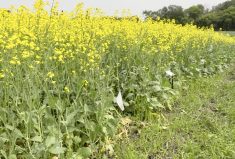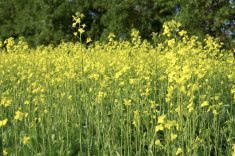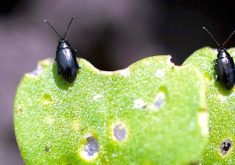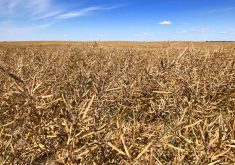Straight combining canola can save time and manpower – two things in short supply, especially on larger farms. But novices should ease into it.
“A big thing if you’re moving to straight cutting is start small and build,” Derwyn Hammond, an agronomy specialist with the Canola Council of Canada told farmers attending Ag Days Jan. 20.
“Producer experience is one key thing that we’ve seen that can really help enhance the success with straight cutting.”
Read Also

Manitoba sclerotinia picture mixed for 2025
Variations in weather and crop development in this year’s Manitoba canola fields make blanket sclerotinia outlooks hard to pin down
Trials have shown straight-combined fields can yield within 10 per cent of swathed fields, or even better sometimes.
“But there’s always those couple of trials where you lost a third to half of your yield,” Hammond said in an interview later. “We’ve seen losses up to 50 per cent when you compare swathing to straight cutting as well in individual trials. It boils down to what’s a grower’s stomach for that kind of risk.”
More suited
Some fields are better suited for straight cutting than others.
“Something that’s leaned over with all the pods knitted together is the best candidate,” Hammond said. “If the crop is hard to walk through that means those plants are twined together very well.”
The same things farmers do to get big yields also help mitigate shattering when straight combining, Hammond said. For example, good fertility can produce a thick crop that will be less likely to move in the wind.
Even seed maturity makes straight combining easier too. That starts with spring seeding and getting even germination with a plant stand of at least 10 plants per square foot.
“If you have a nice uniform stand you’ll… tend to have more uniform maturity so… you’re not going to have to wait as long for that crop to get ready to combine,” Hammond said. “That means it’s out there and vulnerable for a shorter period of time and that can help mitigate your risk.”
Slow down
Seeding speed has a big impact on seeding depth and therefore the plant stand. In one trial, where the goal was to plant canola three-quarters of an inch deep, seed planted at 4.1 miles per hour (m. p. h.) ranged in depth from 0.5 to 1.25 inches. At 5.0 m. p. h. the depth ranged between 0.5 to 1.75 inches, but at 6.2 m. p. h. it jumped from 0.0 (seed on the soil surface) to 3.0 and averaging 1.5 inches deep.
Seeding at higher speeds also resulted in a lot more soil disturbance.
Seed planted at 4.1 m. p. h. produced a stand of nine plants per square foot, which is close to the target of 10. The number of plants dropped to 4.8 plants per square foot when planted at 6.2 m. p. h.
“That’s not a level where you would reseed, but it’s certainly not the level where you would get the optimum performance out of the genetics he’s putting in the ground,” Hammond said.
Combine speed is important too. Feeding the crop smoothly into the combine reduces losses. The crop should be cut just below the pods, minimizing the volume of plant material going through the combine, Hammond said.
“Set the reel back as far as you can so that any shattering that occurs, the seeds drop into the throat of the combine versus in front of the knife,” he said.
Assess fields
Fields to be straight combined should be assessed just before the time they would normally be swathed. Then there’s time to swath if for some reason, such as disease or uneven maturity, that’s the better option.
Swathing should ideally be done when 60 per cent of the seed has changed colour. That’s when the farmer will get maximum yield and quality without significant shattering, Hammond said. But farmers with lots of acres can’t necessarily wait that long. Hammond said swathing at 25 to 30 per cent seed colour change captures most of the potential yield.
Hammond also stressed it’s the colour of the seed, not the pod that’s important when deciding when to swath.
“It (pod colour) does tell you a little bit about how prone those plants may be to shattering,” he said. “If they are turning really yellow and the seeds are staying green those aren’t as good a candidate for waiting right to that 60 per cent seed colour change (to swath).”
Tough
Straight-cut canola may come off a bit tough so it needs to be dried or stored in an aerated bin. Even dry canola, straight combined, could have a higher oil content making cooling down in the bin critical for safe, long-term storage.
To reduce shattering while straight combining, cut as high as possible and feed the crop evenly into the machine, with the reel far back so that when pods do shatter the seed falls into the throat of the combine instead of on the ground.
More independent research is needed to decide whether the products designed to reduce pod shattering are cost effective, Hammond said. Like any new technology, farmers should try it on a small number of acres and leave a check strip. Farmers should compare the treated and untreated straight-combined canola with yields from swathed canola to see if one works better than the other and whether the sealant pays.



















